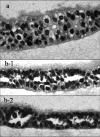Induction of the differentiation of cultured endometrial carcinoma cells by type I collagen: Relevance of sulfolipids
- PMID: 22966267
- PMCID: PMC3436380
- DOI: 10.3892/ol_00000021
Induction of the differentiation of cultured endometrial carcinoma cells by type I collagen: Relevance of sulfolipids
Abstract
This study aimed to promote gland formation in cells derived from endometrial cancer, and assess the relevance of sulfolipids by performing culture with type I collagen. Tumors were developed in nude mice using cultured cell lines, gland formation was induced by culture with type I collagen and the composition of tumor cell sulfolipids was analyzed. Results showed that after culturing the cells on type I collagen gel, the gel was floated. Another layer of gel was placed on top so that the cells were sandwiched between two layers. Using this method, it was possible to induce gland formation in cells that formed only poorly differentiated tumors in nude mice. Mucous staining and electron microscopy demonstrated polarity of the glands. The cell lines that showed gland formation expressed sulfolipids, but not cholesterol sulfate. In conclusion, type I collagen and sulfolipids are involved in the process of gland formation in endometrioid adenocarcinoma.
Figures




Similar articles
-
Extracellular matrix components regulating glandular differentiation and the formation of basal lamina of a human pancreatic cancer cell line in vitro.Exp Cell Res. 1994 Apr;211(2):175-82. doi: 10.1006/excr.1994.1075. Exp Cell Res. 1994. PMID: 8143763
-
Interaction of human trophoblast cells with gland-like endometrial spheroids: a model system for trophoblast invasion.Hum Reprod. 2015 Apr;30(4):906-16. doi: 10.1093/humrep/dev011. Epub 2015 Feb 5. Hum Reprod. 2015. PMID: 25662813
-
[Reorganization of human ovarian adenocarcinoma cells and endometrial adenocarcinoma cells cultured in double-layered floating collagen gels].Nihon Sanka Fujinka Gakkai Zasshi. 1986 Dec;38(12):2157-70. Nihon Sanka Fujinka Gakkai Zasshi. 1986. PMID: 3027213 Japanese.
-
Laminin mediates basement membrane induced differentiation of HEC 1B endometrial adenocarcinoma cells.Biochem Cell Biol. 1996;74(6):875-86. doi: 10.1139/o96-093. Biochem Cell Biol. 1996. PMID: 9164656
-
Cell biology of human ovarian surface epithelial cells and ovarian carcinogenesis.Med Electron Microsc. 2003 Jun;36(2):74-86. doi: 10.1007/s00795-002-0196-6. Med Electron Microsc. 2003. PMID: 12886939 Review.
Cited by
-
Enhanced expression of unique gangliosides with GM2-determinant in human uterine cervical carcinoma-derived cell lines.Glycoconj J. 2016 Oct;33(5):745-54. doi: 10.1007/s10719-016-9668-0. Epub 2016 Jun 6. Glycoconj J. 2016. PMID: 27270764
References
-
- Hopfer H, Rinehart CA, Kaufman DG, Vollmer G. Basement membrane induced differentiation of HEC-1B(L) endometrial adenocarcinoma cells affect both morphology and gene expression. Biochem Cell Biol. 1996;74:165–177. - PubMed
-
- Kubushiro K, Kojima K, Mikami M, Nozawa S, Iizuka R, Iwamori M, Nagai Y. Menstrual cycle-associated alteration of sulfogalactosylceramide in human uterine endometrium. Arch Biochem Biophys. 1989;268:129–136. - PubMed
-
- Kiguchi K, Takamastu K, Tanaka J, Nozawa S, Iwamori M, Nagai Y. Glycosphingoplipids of various human ovarian tumors: a significantly high expression of I3SO3 GalCer and Lewis antigen in mucinous cyst adenocarcinoma. Cancer Res. 1992;52:416–421. - PubMed
-
- Kubushiro K, Tsukazaki K, Tanaka J, Takamastu K, Kuguchi K, Mikami M, Nozawa S, Nagai Y, Iwamori M. Human uterine endometrial adenocarcinoma: characteristic acquirement of synthetic potentials for II3SO3-LacCer and Ganglio series sulfoglycosphingolipids after transfer of the cancer cells to culture. Cancer Res. 1992;52:803–809. - PubMed
-
- Nozawa S, Sakayori M, Ohta K, Iizuka R, Mochizuki H, Soma M, Fujimoto J, Hata J, Iwamori M, Nagai Y. A monoclonal antibody (MSN-1) against a newly established uterine endometrial cancer cell lines (SNG-II) and its application to immunohistochemıstry and flow cytometry. Am J Obstet Gynecol. 1989;161:1079–1086. - PubMed
LinkOut - more resources
Full Text Sources
